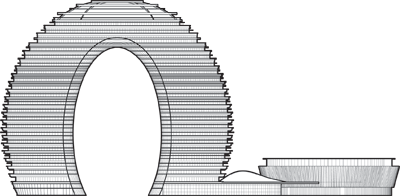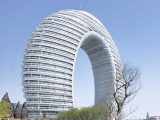Sheraton Huzhou Hot Spring Resort
Huzhou
- CTBUH Drawing
- Facts
-
Metrics
You must be a CTBUH Member to view this resource.
- Structure
To Tip:
Height is measured from the level of the lowest, significant, open-air, pedestrian entrance to the highest point of the building, irrespective of material or function of the highest element (i.e., including antennae, flagpoles, signage and other functional-technical equipment).Architectural:
Height is measured from the level of the lowest, significant, open-air, pedestrian entrance to the architectural top of the building, including spires, but not including antennae, signage, flag poles or other functional-technical equipment. This measurement is the most widely utilized and is employed to define the Council on Tall Buildings and Urban Habitat (CTBUH) rankings of the "World's Tallest Buildings."Occupied:
Height is measured from the level of the lowest, significant, open-air, pedestrian entrance to the highest occupied floor within the building.Above Ground
The number of floors above ground should include the ground floor level and be the number of main floors above ground, including any significant mezzanine floors and major mechanical plant floors. Mechanical mezzanines should not be included if they have a significantly smaller floor area than the major floors below. Similarly, mechanical penthouses or plant rooms protruding above the general roof area should not be counted. Note: CTBUH floor counts may differ from published accounts, as it is common in some regions of the world for certain floor levels not to be included (e.g., the level 4, 14, 24, etc. in Hong Kong).Below Ground
The number of floors below ground should include all major floors located below the ground floor level.
Official Name
Sheraton Huzhou Hot Spring Resort
Other Names
Moon Hotel, Sheraton Tai Lake Resort
Type
Building
Status
Completed
Completion
2013
Country
City
Address
Function
A mixed-use tall building contains two or more functions (or uses), where each of the functions occupy a significant proportion of the tower's total space. Support areas such as car parks and mechanical plant space do not constitute mixed-use functions. Functions are denoted on CTBUH "Tallest Building" lists in descending order, e.g., "hotel/office" indicates hotel function above office function.
Hotel
Structural Material
Both the main vertical/lateral structural elements and the floor spanning systems are constructed from steel. Note that a building of steel construction with a floor system of concrete planks or concrete slab on top of steel beams is still considered an “all-steel” structure as the concrete elements are not acting as the primary structure.
All-Concrete
Both the main vertical/lateral structural elements and the floor spanning systems are constructed from concrete which has been cast in place and utilizes steel reinforcement bars and/or steel reinforced concrete which has been precast as individual components and assembled together on-site.
All-Timber
Both the main vertical/lateral structural elements and the floor spanning systems are constructed from timber. An all-timber structure may include the use of localized non-timber connections between timber elements. Note that a building of timber construction with a floor system of concrete planks or concrete slab on top of timber beams is still considered an “all-timber” structure as the concrete elements are not acting as the primary structure.
Mixed-Structure
Utilizes distinct systems (e.g. all-steel, all-concrete, all-timber), one on top of the other. For example, a Steel Over Concrete indicates an all-steel structural system located on top of an all-concrete structural system, with the opposite true of Concrete Over Steel.
Composite
A combination of materials (e.g. steel, concrete, timber) are used together in the main structural elements. Examples include buildings which utilize: steel columns with a floor system of reinforced concrete beams; a steel frame system with a concrete core; concrete-encased steel columns; concrete-filled steel tubes; etc. Where known, the CTBUH database breaks out the materials used within a composite building’s primary structural elements.
Concrete Over Steel
Official Website
Height
102.2 m / 335 ft
Floors Above Ground
22
Floors Below Ground
2
# of Parking Spaces
50
# of Elevators
7
Top Elevator Speed
3.5 m/s
Tower GFA
30,799 m² / 331,518 ft²
Structural Details:
Bottom of Building
Top of Building
Rankings
-
By function
You must be a CTBUH Member to view this resource.
-
By material
You must be a CTBUH Member to view this resource.
Construction Schedule
Proposed
Construction Start
Completed
Material Supplier
Material Supplier refers to organizations which supplied significant systems/materials for a building project (e.g. elevator suppliers, facade suppliers, etc).
Material Supplier refers to organizations which supplied significant systems/materials for a building project (e.g. elevator suppliers, facade suppliers, etc).
You must be a CTBUH Member to view this resource.
Owner
Sheraton Huzhou Hot Spring Resort
Developer
Feizhou Group
Architect
Usually involved in the front end design, with a "typical" condition being that of a leadership role through either Schematic Design or Design Development, and then a monitoring role through the CD and CA phases.
MAD Architects
Structural Engineer
The Design Engineer is usually involved in the front end design, typically taking the leadership role in the Schematic Design and Design Development, and then a monitoring role through the CD and CA phases.
China Majesty Steel Structural Design Co., Ltd.
MEP Engineer
The Design Engineer is usually involved in the front end design, typically taking the leadership role in the Schematic Design and Design Development, and then a monitoring role through the CD and CA phases.
China Majesty Steel Structural Design Co., Ltd.
Contractor
The main contractor is the supervisory contractor of all construction work on a project, management of sub-contractors and vendors, etc. May be referred to as "Construction Manager," however, for consistency CTBUH uses the term "Main Contractor" exclusively.
Shanghai Xian Dai Architecture Design (Group) Co., Ltd.
Other Consultant
Other Consultant refers to other organizations which provided significant consultation services for a building project (e.g. wind consultants, environmental consultants, fire and life safety consultants, etc).
Other Consultant refers to other organizations which provided significant consultation services for a building project (e.g. wind consultants, environmental consultants, fire and life safety consultants, etc).
These are firms that consult on the design of a building's façade. May often be referred to as "Cladding," "Envelope," "Exterior Wall," or "Curtain Wall" Consultant, however, for consistency CTBUH uses the term "Façade Consultant" exclusively.
Zhejiang Zhongnan Curtain Wall Co., Ltd.
EDSA
Material Supplier
Material Supplier refers to organizations which supplied significant systems/materials for a building project (e.g. elevator suppliers, facade suppliers, etc).
Material Supplier refers to organizations which supplied significant systems/materials for a building project (e.g. elevator suppliers, facade suppliers, etc).
CTBUH Awards & Distinctions
Best Tall Building, by Region, Asia & Australasia 2014 Award of Excellence
2014 CTBUH Awards
Videos

21 September 2012 | Huzhou
Building Information Modeling: An Innovative Process for Better Integration
This presentation analyzes and contrasts traditional 2D design and construction to the possibilities provided by Building Information Modeling. BIM technology represents a significant step forward...
Research

19 September 2012
Building Information Modeling: An Innovative Process for Better Integration
Jun Su, ISA Architecture
This article based on the analysis of the constraints of traditional 2D design and construction to current architectural creation and production quality. It summarizes BIM...
About Sheraton Huzhou Hot Spring Resort
The Sheraton Moon Tai Lake Resort hotel is located next to Nan Tai Lake in Huzhou, a city situated west of Shanghai and north of Hangzhou, with views to Suzhou and Wuxi across the lake. Since ancient times, Huzhou has been known as “the house of silk” and “the land of plenty," and is the only ancient cultural city in the Nan Tai Lake region. The hotel connects with this local context, referencing both traditional and modern conditions, and is iconic in its integration and reflective dialogue with the waterscape of Tai Lake.
The Moon Hotel takes full advantage of its waterfront by directly integrating architecture and nature. The circular building corresponds with its reflection in the water, creating a surreal image and mutable connection between solid reality and an aquatic phantom. Beneath the sunlight and the reflection of the lake, the curved shape of the building is crystal clear. When night falls, the entire building is brightly illuminated by both its interior and exterior lighting. Soft light wraps around the hotel and the water, resembling the bright moon rising above the lake, blending classical China and modern China in an interlocking embrace.
From the beginning, designing an inhabitable vertical glass ring posed a great challenge for the structural engineers. It was eventually decided that a reinforced concrete-core tube would be most lightweight, most capable of containing a dense program, and most earthquake-resistant. However, it was also a challenge to implement a concrete structure and meet the goal of reducing environmental pollution during construction. The mesh-covered, curved surface structure gives the building its necessary rigidity, which is further enhanced by the bridge-like bracing steel structure that connects with the double-cone structure at the top floor. The hotel façade is covered with layers of fine-textured white aluminum rings and glass, creating a sense of drama and ambiguity around the building's scale.
The thin shape of the structure allows for maximal ventilation to the various rooms and suites. Each floor also has open-air terraces, shielding the interior from direct sunlight during the summer, while allowing for sunlight to penetrate the interior during winter. It is common to see people enjoying the sunlit warmth from their balconies during the summer. The outdoor space at the top of the structure acts to supplant the footprint at the ground by providing a roof garden for the enjoyment of guests.
The annular shape of the hotel provides all rooms with favorable views of the waterfront and surrounding city, while allowing for maximal natural light in all directions. The arc-like public space at the top of the building has great open views and acts as a “mid-air” multi-purpose room for large-scale activities. The experience of being at the top invokes a feeling of floating over the lake.
Through all of these gestures, the Moon Hotel emphasizes the harmony between man and nature, and enhances visitors' sensual and spiritual experiences. It stands as Huzhou's new symbol of the connection between humanity and nature, past, present and future.
CTBUH Awards & Distinctions
Best Tall Building, by Region, Asia & Australasia 2014 Award of Excellence
2014 CTBUH Awards
Subscribe below to receive periodic updates from CTBUH on the latest Tall Building and Urban news and CTBUH initiatives, including our monthly newsletter. Fields with a red asterisk (*) next to them are required.
View our privacy policy


